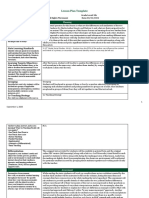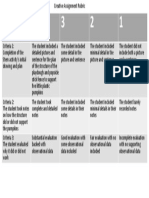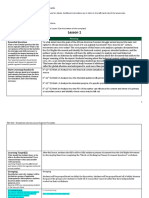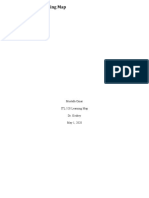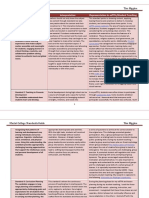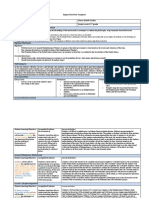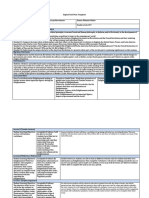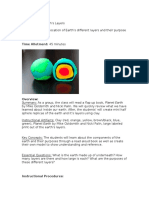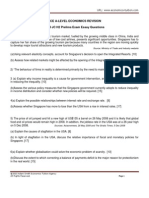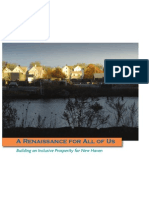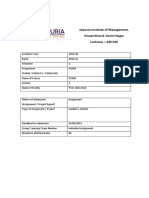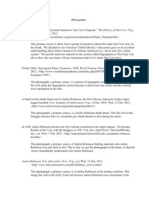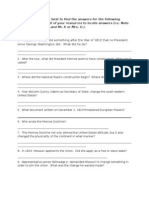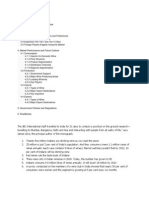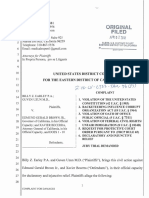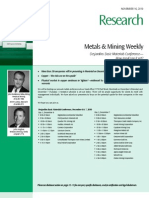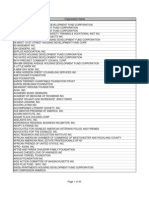11th Grade U.S. History NGSSS-SS Pacing Guide 1st 9 Weeks
11th Grade U.S. History NGSSS-SS Pacing Guide 1st 9 Weeks
Uploaded by
Adrian CarpioCopyright:
Available Formats
11th Grade U.S. History NGSSS-SS Pacing Guide 1st 9 Weeks
11th Grade U.S. History NGSSS-SS Pacing Guide 1st 9 Weeks
Uploaded by
Adrian CarpioCopyright
Available Formats
Share this document
Did you find this document useful?
Is this content inappropriate?
Copyright:
Available Formats
11th Grade U.S. History NGSSS-SS Pacing Guide 1st 9 Weeks
11th Grade U.S. History NGSSS-SS Pacing Guide 1st 9 Weeks
Uploaded by
Adrian CarpioCopyright:
Available Formats
MIAMI-DADE COUNTY PUBLIC SCHOOLS District Pacing Guide- Social Studies GRADE LEVEL OR COURSE TITLE: United States
History Course Code: 2100310
COURSE DESCRIPTION: The grade 9-12 United States History course consists of the following content area strands: United States History, Geography, and Humanities. The primary content emphasis for this course pertains to the study of United States history from Reconstruction to the present day. Students will be exposed to the historical, geographic, political, economic, and sociological events which influenced the development of the United States and the resulting impact on world history. So that students can clearly see the relationship between cause and effect in historical events, students should have the opportunity to review those fundamental ideas and events which occurred before the end of Reconstruction. Honors/Advanced courses offer scaffolded learning opportunities for students to develop the critical skills of analysis, synthesis, and evaluation in a more rigorous and reflective academic setting. Students are empowered to perform at higher levels as they engage in the following: analyzing historical documents and supplementary readings, working in the context of thematically categorized information, becoming proficient in note-taking, participating in Socratic seminars/discussions, emphasizing free-response and document-based writing, contrasting opposing viewpoints, solving problems, etc. Students will develop and demonstrate their skills through participation in a capstone and/or extended researchbased paper/project (e.g., history fair, participatory citizenship project, mock congressional hearing, projects for competitive evaluation, investment portfolio contests, or other teacher-directed projects). The following pacing guide replaces the Competency-Based Curriculum for Social Studies as the required curriculum for grades K-12 in Miami-Dade County Public Schools. Please note the following important general information regarding the Pacing Guides: The Pacing Guides outline the required curriculum for social studies, grades K-12, in Miami-Dade County Public Schools. Social Studies Pacing Guides have been developed for all elementary grade levels (K-5) and for each of the required social studies courses at the middle and senior high school levels. The Social Studies Pacing Guides are to be utilized by all teachers, grades K-12, when planning for social studies instruction. The Pacing Guides outline the required sequence in which the grade level or course objectives are to be taught. The Pacing Guides outline the pacing in which instruction should occur. Specifically, the Pacing Guides are divided into 9 week segments and provide an estimate of the number of traditional or block days needed to complete instruction on a given topic. Teachers should make every effort to stay on pace and to complete the topics in a given nine weeks. Slight variations in pacing may occur due to professional decisions made by the teacher or because of changes in school schedules.
NOTE: Content benchmarks that are highlighted in red are benchmarks that are tested on the End of Course Exam for U.S. History- 11 th grade.There are 18 tested content benchmarks and one tested skill benchmark. NOTE: Associated with each red highlighted benchmark is a link to a lesson plan (highlighted in yellow) complete with all readings, handouts, a detailed lesson plan, and a pre-post quiz to be used during instruction in order to emphasize the importance of tested benchmarks. Note: Skill benchmarks that are tested on the End of Course Exam for U.S. History are highlighted in green throughout the pacing guide. Said skill benchmark is embedded in each content lesson plan. Separate skill lesson plans do not exist. Each Social Studies Pacing Guide is divided into the following headings/categories to assist teachers in developing lesson plans:
Grade Level or Course Title - The grade level and course title are listed in the heading of each page. Course Code - The Florida Department of Education Course Code is listed for the course. Topic - The general topic for instruction is listed; e.g., Westward Expansion. Pacing - An estimated number of traditional or block instructional days needed to complete instruction on the topic is provided. Strands and Standards Strands and Standards from the Next Generation Sunshine State Standards (NGSSS) are provided for each topic. Nine Week Grading Period - Grading periods (1-4) are identified. Essential Content This critically important column provides a detailed list of content/topics and sub topics to be addressed during instruction.
NGSSS-SS Benchmarks This critically important column lists the required instructional Benchmarks that are related to the particular topic. The Benchmarks are divided into Content Benchmarks and Skill Benchmarks. These benchmarks should be identified in the teachers lesson plans.
Curriculum and Instruction: Division of Social Sciences and Life Skills Pacing Guide
MIAMI-DADE COUNTY PUBLIC SCHOOLS District Pacing Guide- Social Studies GRADE LEVEL OR COURSE TITLE: United States History Course Code: 2100310
Instructional Tools - This column provides suggested resources and activities to assist the teacher in developing engaging lessons and pedagogically sound instructional practices. The Instructional Tools column is divided into the following subparts: Core Text Book, Key Vocabulary, Technology (Internet resources related to a particular topic), Suggested Activities, Assessment, English Language Learner (ELL) Instructional Strategies, Related Programs (National, State, and/or District programs as they relate to a particular topic), and SPED (A link to the NGSSS-SS Access Points for Students with Cognitive Disabilities). Internet resources applicable to all Essential Content and Suggested Activities relevant to this course and found in this pacing guide: M-DCPS Department of Social Sciences: http://socialsciences.dadeschools.net/ National Council for the Social Studies: http://www.ncss.org/ America: A History of Intersections: http://www.tahgrant.dadeschools.net/jan.10.asp Best of History Website: http://www.besthistorysites.net/index.shtml Federal Resources for Education Excellence (Primary Documents): http://ed.gov/free/ Graphic Organizers (ARTIST & SPEECH): http://www.tahgrant.dadeschools.net/jan10.asp History Channel: http://www.history.com/ History On-Line: http://www.history.ac.uk/ihr/Resources/Type/index.html The Last Word: http://www.tahgrant.dadeschools.net/dec.09.asp The Miami Herald: http://www.miamiherald.com/ MSNBC Daryl Cagles Political Cartoonists Index: http://www.cagle.com/teacher/ National Archives: www.archives.gov/ The Newseum: http://www.newseum.org/education/teacher-resources/teacher-planning/index.html New York Times: http://www.nytimes.com/ PowerPoint Website: http://pptpalooza.net/ Public Broadcasting Service: http://www.pbs.org/teachers/classroom/9-12/social-studies/resources/ and http://www.pbs.org/wgbh/amex/teachers/index.html Smithsonian Education: http://smithsonianeducation.org/educators/lesson_plans/history_culture.html Teaching American History: http://www.tahgrant.net/index.html U.S. Library of Congress: http://www.loc.gov/index.html The Washington Times: http://www.washingtontimes.com/
Curriculum and Instruction: Division of Social Sciences and Life Skills Pacing Guide
MIAMI-DADE COUNTY PUBLIC SCHOOLS District Pacing Guide- Social Studies GRADE LEVEL OR COURSE TITLE: United States History Websites for Research: http://library.pba.edu/Research_Websites.htm White Out Strategy: http://www.tahgrant.dadeschools.net/apr.10.asp Topic 1: CAUSES, COURSE, AND CONSEQUENCES OF THE CIVIL WAR AND RECONSTRUCTION AND EFFECTS ON THE AMERICAN PEOPLE (1861-1877) Pacing: Traditional: 19 Days Block: 9.5 Days Course Code: 2100310
STRAND(S) and STANDARD(S): American History (Standard 1: Use research and inquiry skills to analyze American history using primary and secondary sources; Standard 2: Understand the causes, course, and consequences of the Civil War and Reconstruction and its effects on the American people.) Geography (Standard 1: Understand how to use maps and other geographic representations, tools, and technology to report information; Standard 2: Understand physical and cultural characteristics of places; Standard 4: Understand the characteristics, distribution, and migration of human populations.) Humanities (Standard 1: Identify and analyze the historical, social, and cultural contexts of the arts; Standard 3: Understand how transportation, trade, communication, science and technology influence the progression and regression of cultures.) First Nine Weeks NGSSS-SS Benchmarks Content Benchmarks: SS.912.A.2.1: Review the causes and consequences of the Civil War.End of Course Exam Benchmark Click on the following link for a detailed lesson plan, reading, instructional materials and pre-post quiz questions to assist in the instruction of the tested benchmark above: http://socialsciences.dadeschools.net/pdf/socialstudies_less on_plans/Q1/Social%20Studies%20Lesson%20Plan%20%20SS.912.A.2.1.pdf SS.912.A.2.2: Assess the influence of significant people or groups on Reconstruction. SS.912.A.2.3: Describe the issues that divided Republicans during the early Reconstruction era. SS.912.A.2.4: Distinguish the freedoms guaranteed to African Americans and other groups with the 13th, 14th, and 15th Amendments to the Constitution. SS.912.A.2.5: Assess how Jim Crow Laws influenced life for African Americans and other racial/ethnic minority groups. SS.912.A.2.6: Compare the effects of the Black Codes and the Nadir on freed people, and analyze the sharecropping system and debt peonage as practiced. in the Instructional Tools Core Text Book: TBA Vocabulary/Identification: Popular sovereignty, free soil, underground railroad, confederacy, blockade, cotton diplomacy, habeas corpus, conscription, Copperheads, Black Codes, impeachment, Carpetbaggers, Scalawags, Reconstruction, Radical Republicans, KKK, home rule, New South, Jim Crow, sharecropping, tenant farmers, poll taxes, grandfather clause, literacy tests, amnesty, freedmen, "Solid South" Technology: John Brown Trial Links http://www.law.umkc.edu/faculty/proejcts/ftrials/Brown.html For information about the trial of John Brown, this site provides a list of excellent links. Abraham Lincoln and Slavery http://odur.let.rug.nl/-usa/H/1990/ch5_p6.htm This site discusses Lincolns views and actions concerning slavery , especially the Lincoln-Douglas Debates. Bleeding Kansas http://www.kancoll.org/galbks.htm Contemporary and later accounts of Americas rehearsal for the Civil War comprise this University of Kansas site. The Compromise of 1850 and the Fugitive Slave Act http://www.pbs.org/wgbh/aia/part4 From the series on Africans in America, an analysis of the Compromise of 1850
Essential Content CAUSES: Sectionalism and Slavery Lead to the Civil War o Fundamental Economic Differences Between the North and the South o Sectional Differences Over the Bank, Protective Tariffs, Internal Improvements, & the Extension of Slavery into New Territories o States Rights, Nullification, Secession vs. National Theory o Compromise of 1820 (Missouri Compromise) o The Wilmot Proviso (1846) o Compromise of 1850 (Popular Sovereignty, Fugitive Slave Law) o Publication of Uncle Toms Cabin o Kansas-Nebraska Act (1854): "Bleeding Kansas" o Formation of the
Curriculum and Instruction: Division of Social Sciences and Life Skills Pacing Guide
MIAMI-DADE COUNTY PUBLIC SCHOOLS District Pacing Guide- Social Studies GRADE LEVEL OR COURSE TITLE: United States History Essential Content Republican Party Lecompton Constitution Dred Scott vs. Sandford (1857) Abolitionist Movement: Frederick Douglass, William Lloyd Garrison, Harriet Tubman Lincoln-Douglas Debates John Browns Raid at Harpers Ferry Election of 1860: Abraham Lincoln Secession Crisis South Carolinas Ordinance of Secession States seceding after Lincolns inauguration vs. states seceding After Fort Sumter Florida secedes and joins the Confederacy THE CIVIL WAR (1861-1865) o Formation of the Confederacy: Jefferson Davis o Inauguration of Lincoln o Advantages & Disadvantages: North vs. South o Mobilization: Conscription and Funding o The Anaconda Plan o Diplomacy: the Trent Affair, Course Code: 2100310
First Nine Weeks NGSSS-SS Benchmarks Instructional Tools United States. and of the effects of the Fugitive Slave Act on black Americans. SS.912.A.2.7: Review the Native American experience. Skill Benchmarks: SS.912.A.1.1: Describe the importance of historiography, which includes how historical knowledge is obtained and transmitted, when interpreting events in history. SS.912.A.1.2: Utilize a variety of primary and secondary sources to identify author, historical significance, audience, and authenticity to understand a historical period. SS.912.A.1.3: Utilize timelines to identify the time sequence of historical data. SS.912.A.1.4: Analyze how images, symbols, objects, cartoons, graphs, charts, maps, and artwork may be used to interpret the significance of time periods and events from the past. SS.912.A.1.5: Evaluate the validity, reliability, bias, and authenticity of current events and Internet resources. SS.912.A.1.6: Use case studies to explore social, political, legal, and economic relationships in history. SS.912.A.1.7: Describe various socio-cultural aspects of American life including arts, artifacts, literature, education, and publications. SS.912.G.1.2: Use spatial perspective and appropriate geographic terms and tools, including the Six Essential Elements, as organizational schema to describe any given place. SS.912.G.1.3: Employ applicable units of measurement and scale to solve simple locational problems using maps and globes. SS.912.G.2.1: Identify the physical characteristics and the human characteristics that define and differentiate regions. SS.912.G.4.2: Use geographic terms and tools to analyze the push/pull factors contributing to human migration within The 1850s: An Increasingly Divided Union http://www.thoughtfultech.com/MMTS/50essay.html A tutorial skills development site focusing on the events in the 1850s leading to the Civil War; from MMTS, the Multi-Media Thinking Skills project. Words and Deeds in American History http://lcweb2.loc.gov/ammem/mcchtml/corhome.html A Library of Congress site containing links to Frederick Douglass; the Compromise of 1850; speeches by John C. Calhoun, Daniel Webster, and Henry Clay; and other topics from the Civil War era. The American Civil War Homepage http://sunsite.utk.edu/civil-war/warweb.html This site has a great collection of hypertext links to the most useful identified electronic files about the American Civil War. Abraham Lincoln Association http://www.alincolnassoc.com/ This site allows the search of digital versions of Lincolns papers. U.S. Civil War Center http://www.cwc.lsu.edu/ This is a site whose mission is to locate, index, and/or make available all appropriate private and public data regarding the Civil War and to promote the study of the Civil War from the perspectives of all professions, occupations, and academic disciplines. History of African-Americans in the Civil War http://www.itd.nps.gov/cwss/history/aa_history.htm This National Park Service site explores the history of the United States AfricanAmerican Troops. Civil War Women http://scriptorium.lib.duke.edu/collections/civil-war-women.html This site includes original documents, links, and biographical information about several women and their lives during the Civil War. Assassination of President Abraham Lincoln http://memory.loc.gov/ammem/alhtml/alrintr.html Part of the American Memory series with introduction, timeline, and gallery. Selected Civil War Photographs
o
o
o o o o
Curriculum and Instruction: Division of Social Sciences and Life Skills Pacing Guide
MIAMI-DADE COUNTY PUBLIC SCHOOLS District Pacing Guide- Social Studies GRADE LEVEL OR COURSE TITLE: United States History Essential Content the Alabama Claims, the Maximilian Affair Lincoln as War-Time President First inaugural address Civil liberties: Suspension of habeas corpus Martial law Copperheads & draft riots Emancipation Proclamation Gettysburg Address Role of Women and African Americans The Impact of the Civil War on Native Americans Main Events of the War Blockade of the South: the Monitor vs. the Merrimac Control of the Mississippi: Battle of Vicksburg The War in the East Battle of Bull Run Battle of Antietam Battle of Gettysburg Florida: Battles Grant Takes Charge of Richmond Campaign Sherman Course Code: 2100310
First Nine Weeks NGSSS-SS Benchmarks Instructional Tools and among places. http://memory.lco.gov/ammem/cwphtml/cwphome.html The Library of Congress site with more than 1,000 photographs, many from SS.912.G.4.3: Use geographic terms and tools to analyze Matthew Brady. the effects of migration both on the place of origin and destination, including border areas. A Timeline of the Civil War http://www.historyplace.com/civilwar/index.html SS.912.H.1.1: Relate works in the arts (architecture, dance, A complete timeline of the Civil War, well illustrated with photographs. music, theatre, and visual arts) of varying styles and genre according to the periods in which they were created. National Civil War Association http://www.ncwa.org/info.html SS.912.H.1.3: Relate works in the arts to various cultures. One of many Civil War reenactment organizations in the United States. SS.912.H.1.5: Examine the artistic response to social issues and new ideas in various cultures. SS.912.H.3.1: Analyze the effects of transportation, trade, communication, science, and technology on the preservation and diffusion of culture. LA.1112.1.6.1: The student will use new vocabulary that is introduced and taught directly. LA.1112.1.6.2: The student will listen to, read, and discuss familiar and conceptually challenging text. LA.1112.1.6.3: The student will use context clues to determine meanings of unfamiliar words. LA.1112.2.2.2: The student will use information from the text to answer questions or to state the main idea or provide relevant details. LA.1112.2.2.3: The student will organize information to show understanding or relationships among facts, ideas, and events (e.g., representing key points within text through charting, mapping, paraphrasing, summarizing, comparing, contrasting, outlining). LA.1112.6.2.4: The student will understand the importance of legal and ethical practices, including laws regarding libel, slander, copyright, and plagiarism in the use of mass media and digital sources, know the associated consequences, and comply with the law. Images of African-Americans from the Nineteenth Century http://digital.nypl.org/schomburg/images_aa19/ The New York Public Library-Schomburg Center for Research and Black Culture site contains numerous visuals. Freedmen and Southern Society Project (University of Maryland College Park) http://www.inform.umd.edu/ARHU/Depts/History/Freedman/home.html This site contains a chronology and sample documents from several print collections or primary sources about emancipation and freedom in the 1860s. History of the Suffrage Movement http://www.rochester.edu/SBA This site includes a chronology, important texts relating to womens suffrage, and biographical information about Susan B. Anthony and Elizabeth Cady Stanton. Suggested Activities: Have students create a chart comparing sectionalism in the North, the South, and the West, which includes the following components: the tariff, the bank, internal improvements, immigration, and extension of slavery. Have students re-trace the routes of the Underground Railroad on a map. Have students create a journal from the perspective of a Union soldier or a Confederate soldier. Have students write a short editorial, either supporting or opposing the Emancipation Proclamation. Have students create a multiple-effects chart depicting the political, economic, and social consequences of the Civil War.
o o o
Curriculum and Instruction: Division of Social Sciences and Life Skills Pacing Guide
MIAMI-DADE COUNTY PUBLIC SCHOOLS District Pacing Guide- Social Studies GRADE LEVEL OR COURSE TITLE: United States History Essential Content s March to the Sea End of the War: Union Victory and Lees Surrender at Appomattox Courthouse Election of 1864 Assassination of Lincoln Course Code: 2100310
o o
First Nine Weeks NGSSS-SS Benchmarks Instructional Tools LA.1112.6.3.1: The student will distinguish between Have students create a timeline illustrating major events, causes, the course, propaganda and ethical reasoning strategies in print and and the consequences of the Civil War. non-print media. Have students create a chart comparing and contrasting the Presidents plan for MA.912.A.2.1: Create a graph to represent a real-world Reconstruction (the 10% Plan) with the Congressional plan. situation. Have students create a newspaper headline from the perspective of the North and the South reflecting public opinion on the assassination of President Lincoln. MA.912.A.2.2: Interpret a graph representing a real-world situation. Have students imagine that they are an African American sharecropper, a carpetbagger, and a White Southern Democrat. Write a paragraph for each supporting their position on Reconstruction. Have students create a newspaper that reflects events, people, and issues of the Civil War from the perspective of the Union and of the Confederacy. PowerPoints: Election of 1860 (http://tahgrant.dadeschools.net/dec09.asp) 1860 Republican Party Platform (http://tahgrant.dadeschools.net/dec09.asp) Democratic Party Platform (http://tahgrant.dadeschools.net/dec09.asp) Constitutional Party Platform (http://tahgrant.dadeschools.net/dec09.asp) Letter to John Breckinridge (http://tahgrant.dadeschools.net/jan10.asp) Causes of the American Civil War (http://tahgrant.dadeschools.net/dec09.asp) Causes of the Civil War Using Primary Sources (http://tahgrant.dadeschools.net/dec09.asp) The Civil War Part I (http://tahgrant.dadeschools.net/dec09.asp) The Civil War Part II (http://tahgrant.dadeschools.net/dec09.asp) The End of the Civil War (http://tahgrant.dadeschools.net/dec09.asp) Assessment: Develop rubrics and share with students for each of the above mentioned projects in order to increase opportunities for mastery of content and historical thinking skills. Each project or assignment should be assessed for content accuracy and skill development in terms of writing and reading comprehension. ELL: Use visual depictions of historical events in order to increase ELL students
CONSEQUENCES o Supremacy of the Federal Government Established: Threat of Secession Ended o Impact on the Economies of North and South o Casualties and Financial Losses o Total War o Slavery Abolished: Thirteenth Amendment RECONSTRUCTION (1865-1877) o Problems of Reconstruction Treatment of the southern states Terms for readmission of southern states Treatment of former Confederates and status of former slaves o Lincolns Reconstruction Plan (Ten Percent Plan) vs. Congressional Plan for Reconstruction (WadeDavis Bill) o Johnson Becomes President (1865); Adopts Lincolns Plan for Reconstruction
Curriculum and Instruction: Division of Social Sciences and Life Skills Pacing Guide
MIAMI-DADE COUNTY PUBLIC SCHOOLS District Pacing Guide- Social Studies GRADE LEVEL OR COURSE TITLE: United States History Essential Content Southern Legislatures Enact Black Codes Congress Rejects Johnsons Program: Radical Republicans Take Control of Reconstruction Freedmans Bureau Act (1866) Fourteenth Amendment (1866) The Civil Rights Act (1866) Reconstruction Act of 1867: South divided into five military districts Republican Control of the South: Carpetbaggers and Scalawags Readmission of Southern States: Ratification of Fourteenth and Fifteenth Amendments Impeachment of Johnson (1868): Tenure of Office Act Election of Grant Political and financial scandals White Southern Democrats Gain Control of the South White supremacy Ku Klux Klan Grants Force Acts to combat the KKK The End of Reconstruction Election of 1876: Hayes vs. Tilden Compromise of 1877: home rule First Nine Weeks NGSSS-SS Benchmarks mastery of related content. Related Programs: Celebrate Freedom Week September See the Division of Social Sciences Website, http://socialsciences.dadeschools.net/. SPED: Go the Division of Social Sciences website, http://socialsciences.dadeschools.net/ and look under Curricular Documents, Next Generation Sunshine State Standards in order to download the PDF of Access Points for Students with Cognitive Disabilities related to this particular grade level. State and District Instructional Requirements: Teachers should be aware that State and District policy requires that all teachers K-12 provide instruction to students in the following content areas: AfricanAmerican History, Character Education, Hispanic Contributions to the United States, Holocaust Education, and Womens Contributions to the U.S. Detailed lesson plans can be downloaded from the Division of Social Sciences and Life Skills website, http://socialsciences.dadeschools.net/, under the headings Character Education and Multicultural Support Documents. Please note that instruction regarding the aforementioned requirements should take place throughout the entire scope of a given social studies course, not only during the particular month or day when a particular cultural group is celebrated or recognized. Instructional Tools Course Code: 2100310
o o
o o
o o o
Curriculum and Instruction: Division of Social Sciences and Life Skills Pacing Guide
MIAMI-DADE COUNTY PUBLIC SCHOOLS District Pacing Guide- Social Studies GRADE LEVEL OR COURSE TITLE: United States History Essential Content (federal troops removed from southern states) Status of Southern Blacks Jim Crow laws: segregation Grandfather clauses, poll taxes, & literacy tests Plessy vs. Ferguson (1896) New South "Solid South" Diversification of agriculture Sharecropping & tenant farmers Industrialization First Nine Weeks NGSSS-SS Benchmarks Instructional Tools Course Code: 2100310
Curriculum and Instruction: Division of Social Sciences and Life Skills Pacing Guide
MIAMI-DADE COUNTY PUBLIC SCHOOLS District Pacing Guide- Social Studies GRADE LEVEL OR COURSE TITLE: United States History Topic 2: FINAL SETTLEMENT OF THE WEST (1862-1890) Course Code: 2100310 Pacing: Traditional: 5 Days Block: 2.5 Days
STRAND(S) and STANDARD(S): American History (Standard 1: Use research and inquiry skills to analyze American history using primary and secondary sources; Standard 2: Understand the causes, course, and consequences of the Civil War and Reconstruction and its effects on the American people; Standard 3: Analyze the transformation of the American economy and the changing social and political conditions in response to the Industrial Revolution.) Geography (Standard 1: Understand how to use maps and other geographic representations, tools, and technology to report information; Standard 2: Understand physical and cultural characteristics of places; Standard 4: Understand the characteristics, distribution, and migration of human populations.) Humanities (Standard 1: Identify and analyze the historical, social, and cultural contexts of the arts; Standard 3: Understand how transportation, trade, communication, science and technology influence the progression and regression of cultures.) First Nine Weeks NGSSS-SS Benchmarks Instructional Tools Content Benchmarks: Core Text Book: TBA SS.912.A.2.7: Review the Native American experience. Vocabulary/Identification: Great Plains, longhorns, Forty-Niners, gold rush, assimilation, open range, SS.912.A.3.1: Analyze the economic challenges to barbed wire, placer mining, dry farming, cowboys, frontier thesis, bonanza farms, American farmers and farmers responses to the challenges Wounded Knee, prospectors, exodusters, speculator, sod, long drive, Chisholm in the mid to late 1800s. End of Course Exam Benchmark. Click on the following link for a detailed lesson plan, reading, Trail, Ghost Dance, range wars, the Grange, populism, Battle of Standards, Overland Trail, bi-metalism, homesteaders, sooners, boomers instructional materials and pre-post quiz questions to assist in the instruction of the tested benchmark above: http://socialsciences.dadeschools.net/pdf/socialstudies_less on_plans/Q1/Social%20Studies%20Lesson%20PlanSS.912.A.3.1.pdf SS.912.A.3.6: Analyze changes that occurred as the United States shifted from agrarian to an industrial society. Skill Benchmarks: SS.912.A.1.1: Describe the importance of historiography, which includes how historical knowledge is obtained and transmitted, when interpreting events in history. SS.912.A.1.2: Utilize a variety of primary and secondary sources to identify author, historical significance, audience, and authenticity to understand a historical period. SS.912.A.1.3: Utilize timelines to identify the time sequence of historical data. SS.912.A.1.4: Analyze how images, symbols, objects, cartoons, graphs, charts, maps, and artwork may be used to interpret the significance of time periods and events from the past. Technology: Indian Affairs: Laws and Treaties, compiled and edited by Charles J. Kappler (1904) http://digital.library.okstate.edu/kappler This digitized text at Oklahoma State University includes pre-removal treaties with the five civilized tribes and other tribes. Native American Documents Project http://www.csusm.edu/projects/nadp/nadp.htm California State University at San Marcos has several digital documents relating to Native Americans on this site. National Museum of the American Indian http://www.si.edu/nmai The Smithsonian Institution maintains this site, providing information about the museum. The museum is dedicated to everything about Native Americans. On the Trail in Kansas http://www.kancoll.org/galtrl.htm This Kansas collection site holds several good primary sources with images concerning the Oregon Trail and Americas early movement westward.
Essential Content MOTIVES FOR MOVING WEST o Trade with Far East o Cheap Land o Farming & Ranching o Mineral Resources o Government Promotion of Settlement: Incentives FACTORS CONTRIBUTING TO SETTLEMENT o Mining Frontier: Gold Rush, Forty-Niners, Prospecting o Cattle Ranching Cowboys: Myth vs. Reality Long Drive Range Wars o Farming Frontier: the Great Plains o Transcontinental Railroad
Incentives: loans, land grants, and right of way Homestead Act (1862)
CONFLICT WITH NATIVE AMERICANS o Resistance to White Settlement o Sioux Wars
Curriculum and Instruction: Division of Social Sciences and Life Skills Pacing Guide
MIAMI-DADE COUNTY PUBLIC SCHOOLS District Pacing Guide- Social Studies GRADE LEVEL OR COURSE TITLE: United States History Essential Content Custers Last Stand Ghost Dance Movement Helen Hunt Jackson's A Century of Dishonor The Dawes Act (1887): Attempted Assimilation First Nine Weeks NGSSS-SS Benchmarks SS.912.A.1.5: Evaluate the validity, reliability, bias, and authenticity of current events and Internet resources. SS.912.A.1.6: Use case studies to explore social, political, legal, and economic relationships in history. SS.912.A.1.7: Describe various socio-cultural aspects of American life including arts, artifacts, literature, education, and publications. SS.912.G.1.2: Use spatial perspective and appropriate geographic terms and tools, including the Six Essential Elements, as organizational schema to describe any given place. SS.912.G.1.3: Employ applicable units of measurement and scale to solve simple locational problems using maps and globes. SS.912.G.2.1: Identify the physical characteristics and the human characteristics that define and differentiate regions. SS.912.G.4.2: Use geographic terms and tools to analyze the push/pull factors contributing to human migration within and among places. SS.912.G.4.3: Use geographic terms and tools to analyze the effects of migration both on the place of origin and destination, including border areas. SS.912.H.1.1: Relate works in the arts (architecture, dance, music, theatre, and visual arts) of varying styles and genre according to the periods in which they were created. SS.912.H.1.3: Relate works in the arts to various cultures. SS.912.H.1.5: Examine the artistic response to social issues and new ideas in various cultures. SS.912.H.3.1: Analyze the effects of transportation, trade, communication, science, and technology on the preservation and diffusion of culture. Course Code: 2100310 Instructional Tools California as I Saw It: First-Person Narratives of Californias Early Years, 1849-190 http://memory.loc.gov/ammem/cbhtml/cbhome.html This site is part of the American Memory series illustrating the formative era of Californias history through eyewitness accounts. It covers the Gold Rush, the interactions of various groups, and settling of the region. Home on the Range/Cowboy Heritage http://history.cc.ukans.edu/heritage/old_west/cowboy.html This site tells the history of the cattle trails and towns such as Dodge City, with useful texts, links, documents, and maps. Suggested Activities: Have students create a poster promoting life in the Great Plains (different territories by group). Have students create a timeline of events, including: Congressional acts, new technologies, and land opportunities that contributed to the westward movement. Have students participate in a simulation of the Oregon Trail. Divide the class into different family wagons. Provide each family with an amount of money to buy supplies and/or barter (weapons, wagon wheels, medicine, food, etc) during trip for necessary items along the way. Teacher will intermittently (during class) announce random setbacks to individual families and the caravan as a whole (death of oxen, flood, Native American attack, sickness, shortage of food, etc). Winners will reach Oregon! Have students read Chief Josephs speech, I Will Fight No More Forever. Make an inference on how U.S. government policy affected Native Americans. Have students write a letter as a settler moving west to a family member left behind on their journey and describe their living conditions after reaching their destination. Have students formulate a list of national parks in the West and label them on a map of the United States. Have students assume the roles of farmers or railroad owners. Have students write letters to newspapers detailing the farmers plight or the opposition to the government regulating railroads. Have students organize a chart that identifies the elements of the Populist Party platform.
o o
o o
CLOSING OF THE FRONTIER (1890) o Frederick Jackson Turners Frontier Thesis o Oklahoma: the Last Frontier ECONOMIC CHALLENGES TO AMERICAN FARMERS o Plight of the Farmer Low prices Foreign competition High mortgage rates High interest rates
High railroad rates High insurance costs High middlemen fees
FARMERS' RESPONSES o o o o o The Grange Movement Farmers Alliances Support for Cheap Paper Money: Pro-Silver Forces Rise of the Populist Party (the People's Party) Populist Party Platform:
Unlimited coinage of silver (16:1) Direct election of U.S. senators One-term limit for
Curriculum and Instruction: Division of Social Sciences and Life Skills Pacing Guide
10
MIAMI-DADE COUNTY PUBLIC SCHOOLS District Pacing Guide- Social Studies GRADE LEVEL OR COURSE TITLE: United States History Essential Content president Initiative & referendum Government ownership of railroads and telegraph Secret ballot Elimination of protective tariff Graduated income tax Eight-hour work day Minimum wage Immigration restrictions ELECTION OF 1896: BRYAN VS. MCKINLEY o Battle of the Standards o Bryan's Cross of Gold Speech o Election of McKinley: Return to the Gold Standard Course Code: 2100310
First Nine Weeks NGSSS-SS Benchmarks Instructional Tools LA.1112.1.6.1: The student will use new vocabulary that is Have students organize a class debate on the issue of gold vs. silver. introduced and taught directly. Have students create political cartoons that depict and illustrate the influence of LA.1112.1.6.2: The student will listen to, read, and discuss the Populist ideology on American political traditions and culture. familiar and conceptually challenging text. PowerPoints: LA.1112.1.6.3: The student will use context clues to The American West (http://tahgrant.dadeschools.net/jan10.asp) determine meanings of unfamiliar words. Homestead Act (http://tahgrant.dadeschools.net/jan10.asp) LA.1112.2.2.2: The student will use information from the text to answer questions or to state the main idea or provide Frederick Jackson Turner Document (http://tahgrant.dadeschools.net/jan10.asp) relevant details. Assessment: Develop rubrics and share with students for each of the above mentioned LA.1112.2.2.3: The student will organize information to projects in order to increase opportunities for mastery of content and historical show understanding or relationships among facts, ideas, thinking skills. Each project or assignment should be assessed for content and events (e.g., representing key points within text through accuracy and skill development in terms of writing and reading comprehension. charting, mapping, paraphrasing, summarizing, comparing, contrasting, outlining). LA.1112.6.2.4: The student will understand the importance of legal and ethical practices, including laws regarding libel, slander, copyright, and plagiarism in the use of mass media and digital sources, know the associated consequences, and comply with the law. LA.1112.6.3.1: The student will distinguish between propaganda and ethical reasoning strategies in print and non-print media. MA.912.A.2.1: Create a graph to represent a real-world situation. MA.912.A.2.2: Interpret a graph representing a real-world situation. ELL: Use visual depictions of historical events in order to increase ELL students mastery of related content. SPED: Go the Division of Social Sciences website, http://socialsciences.dadeschools.net/ and look under Curricular Documents, Next Generation Sunshine State Standards in order to download the PDF of Access Points for Students with Cognitive Disabilities related to this particular grade level. State and District Instructional Requirements: Teachers should be aware that State and District policy requires that all teachers K-12 provide instruction to students in the following content areas: AfricanAmerican History, Character Education, Hispanic Contributions to the United States, Holocaust Education, and Womens Contributions to the U.S. Detailed lesson plans can be downloaded from the Division of Social Sciences and Life Skills website, http://socialsciences.dadeschools.net/, under the headings Character Education and Multicultural Support Documents. Please note that instruction regarding the aforementioned requirements should take place throughout the entire scope of a given social studies course, not only during the particular month or day when a particular cultural group is celebrated or recognized.
Curriculum and Instruction: Division of Social Sciences and Life Skills Pacing Guide
11
MIAMI-DADE COUNTY PUBLIC SCHOOLS District Pacing Guide- Social Studies GRADE LEVEL OR COURSE TITLE: United States History Topic 3: INDUSTRIALIZATION (1865-1900) Course Code: 2100310 Pacing: Traditional: 7 Days Block: 3.5 Days
STRAND(S) and STANDARD(S): American History (Standard 1: Use research and inquiry skills to analyze American history using primary and secondary sources; Standard 3: Analyze the transformation of the American economy and the changing social and political conditions in response to the Industrial Revolution.) Geography (Standard 1: Understand how to use maps and other geographic representations, tools, and technology to report information; Standard 2: Understand physical and cultural characteristics of places; Standard 4: Understand the characteristics, distribution, and migration of human populations.) Humanities (Standard 1: Identify and analyze the historical, social, and cultural contexts of the arts; Standard 3: Understand how transportation, trade, communication, science and technology influence the progression and regression of cultures.) First Nine Weeks NGSSS-SS Benchmarks Instructional Tools Content Benchmarks: Core Text Book: TBA SS.912.A.3.1: Analyze the economic challenges to Vocabulary/Identification: American farmers and farmers' responses to these Bessemer steel process, vertical integration, horizontal integration, Gilded Age, challenges in the mid to late 1800s. political machines, party bosses, trusts, monopoly, patronage, holding company, robber barons, strikes, injunctions, consolidation, patent, interstate commerce, SS.912.A.3.2: Examine the social, political, and economic marketing, investment banking, Mugwumps, graft, captains of industry causes, course, and consequences of the second Industrial Revolution that began in the late 19th century. End of Course Exam Benchmark. Click on the following link for a detailed lesson plan, reading, instructional materials and pre-post quiz questions to assist in the instruction of the tested benchmark above: http://socialsciences.dadeschools.net/pdf/socialstudies_less on_plans/Q1/Social%20Studies%20Lesson%20Plan%20SS.012.A.3.2.pdf SS.912.A.3.3: Compare the first and second Industrial Revolutions in the United States. SS.912.A.3.4: Determine how the development of steel, oil, transportation, communication, and business practices affected the United States economy. SS.912.A.3.5: Identify significant inventors of the Industrial Revolution including African Americans and women. SS.912.A.3.6: Analyze changes that occurred as the United States shifted from agrarian to an industrial society. SS.912.A.3.9: Examine causes, course, and consequences of the labor movement in the late 19th and early 20th centuries. Technology: Alexander Graham Bell Family Papers at the Library of Congress http://memory.loc.gov/ammem/bellhtml/bellhome.html Contains papers from 1862 to 1939. Includes a chronology, images, selected documents, and interpretive essays about Bell. The Richest Man in the World: Andrew Carnegie http://www.pbs.org/wgbh/amex/carnegie/ American Experience/PBS site provides images and text about Carnegies life and activities. John D. Rockefeller and the Standard Oil Company http://www.micheloud.com/FXM/SO/ This study, with accompanying images by Francois Micheloud, tells of the rise of Rockefeller and his mammoth company. American Labor History http://www.geocities.com/CollegePark/Quad/6460/AmLabHist/index.html This site takes a general look at the history of labor in America. Labor-Management Conflict in American History http://www.history.ohio-state.edu/projects/laborconflict/ Ohio State Universitys site includes primary accounts of some major events in the history of the labor management conflict.
Essential Content FACTORS ENCOURAGING INDUSTRIAL GROWTH IN THE LATE NINETEENTH CENTURY o Abundance of Natural Resources & Raw Materials o New Sources of Power o Growing Population of Laborers & Consumers o Availability of Capital & Investments o Technology & Inventions o Expanding Markets o Government Policies that were Pro-Business: High Tariffs, Land Grants, Loans, Laissez-Faire Policy o Improved Transportation & Communications DEVELOPMENTS OF MAJOR INDUSTRIES o Transportation & Communications o Steel o Coal o Oil & Petroleum o Electricity o Meat-Packing o Construction of the Florida Railroad
Curriculum and Instruction: Division of Social Sciences and Life Skills Pacing Guide
12
MIAMI-DADE COUNTY PUBLIC SCHOOLS District Pacing Guide- Social Studies GRADE LEVEL OR COURSE TITLE: United States History Essential Content RISE OF BIG BUSINESS: CORPORATIONS o Business Consolidation Monopolies Trusts Holding Companies Vertical & Horizontal Integration o Government Regulations: Sherman Anti-Trust Act & the Interstate Commerce Commission RESULTS OF INDUSTRIAL GROWTH o Mass Production: More Efficient Production Methods Assembly line Division of labor Labor-saving machinery o New Marketing Techniques: Advertising & Retailing Department stores Catalogues o Emergence of Captains of Industry First Nine Weeks NGSSS-SS Benchmarks SS.912.A.3.13: Examine key events and peoples in Florida history as they relate to United States history. Course Code: 2100310 Instructional Tools Suggested Activities: Have students create a web illustrating factors (technological, communication, growing markets and natural resources) that encouraged the Industrial Revolution. Have students write an essay arguing which invention or development had the greatest impact on society. Have students create a chart that identifies each step in the process of vertical and horizontal integration. Have students create an advertisement for a department store catalogue. Have students analyze a political cartoon that offers a positive depiction of a captain of industry versus a negative depiction of a robber baron. Have students complete a chart by matching dates with inventions and their inventors. Have students create a timeline of major inventions and their inventors, including the contributions of African Americans and women (from 1860-1920). Students should specify how each invention changed the way people lived. Have students identify the goals of the Knights of Labor and the American Federation of Labor. Have students choose an occupation and create a list of demands. Have students work in small groups to analyze the various reasons for strikes during the late 19th century and the governments reaction to labor unrest. Assessment: Develop rubrics and share with students for each of the above mentioned projects in order to increase opportunities for mastery of content and historical thinking skills. Each project or assignment should be assessed for content accuracy and skill development in terms of writing and reading comprehension. ELL: Use visual depictions of historical events in order to increase ELL students mastery of related content. Related Programs: Hispanic Heritage Month September 15 October 15 See the Division of Social Sciences Website, http://socialsciences.dadeschools.net/.
Skill Benchmarks: SS.912.A.1.1: Describe the importance of historiography, which includes how historical knowledge is obtained and transmitted, when interpreting events in history. SS.912.A.1.2: Utilize a variety of primary and secondary sources to identify author, historical significance, audience, and authenticity to understand a historical period. SS.912.A.1.3: Utilize timelines to identify the time sequence of historical data. SS.912.A.1.4: Analyze how images, symbols, objects, cartoons, graphs, charts, maps, and artwork may be used to interpret the significance of time periods and events from the past. SS.912.A.1.5: Evaluate the validity, reliability, bias, and authenticity of current events and Internet resources. SS.912.A.1.6: Use case studies to explore social, political, legal, and economic relationships in history. SS.912.A.1.7: Describe various socio-cultural aspects of American life including arts, artifacts, literature, education, and publications. SS.912.G.1.2: Use spatial perspective and appropriate geographic terms and tools, including the Six Essential Elements, as organizational schema to describe any given place. SS.912.G.1.3: Employ applicable units of measurement and scale to solve simple locational problems using maps and globes. SS.912.G.2.1: Identify the physical characteristics and the human characteristics that define and differentiate regions.
Armour, Morris, Swift Meat-packing Carnegie Steel Duke Tobacco Mellon Aluminum Morgan Finance Rockefeller Oil Vanderbilt Railroads The Gilded Age (18771900): Mark Twain Political machines, patronage, city bosses Economic: unequal
Curriculum and Instruction: Division of Social Sciences and Life Skills Pacing Guide
13
MIAMI-DADE COUNTY PUBLIC SCHOOLS District Pacing Guide- Social Studies GRADE LEVEL OR COURSE TITLE: United States History Essential Content distribution of wealth Art & literary trends: realism INVENTIONS o Telephone Bell o Trans-Atlantic Cable Field o Elevator Otis o Incandescent Light bulb, Phonograph Edison o Sewing Machine Singer & Howe o Kodak Camera Eastman o Electrified subway system o Telegraph Morse o Cash Register o Notable African-American & Women Inventors: Madam C.J. Walker: hair products Elijah McCoy: automatic lubricator for steam engines Sarah Goode: Cabinet bed; first African-American woman to receive a patent Charles Brooks: street sweeper truck John Burr: rotary blade lawn mower Miriam Benjamin: gong and signal chair for hotels Sarah Boone: ironing board THE LABOR MOVEMENT o Poor Working Conditions First Nine Weeks NGSSS-SS Benchmarks SS.912.G.4.2: Use geographic terms and tools to analyze the push/pull factors contributing to human migration within and among places. SS.912.G.4.3: Use geographic terms and tools to analyze the effects of migration both on the place of origin and destination, including border areas. SS.912.H.1.1: Relate works in the arts (architecture, dance, music, theatre, and visual arts) of varying styles and genre according to the periods in which they were created. SS.912.H.1.3: Relate works in the arts to various cultures. SS.912.H.1.5: Examine the artistic response to social issues and new ideas in various cultures. SS.912.H.3.1: Analyze the effects of transportation, trade, communication, science, and technology on the preservation and diffusion of culture. LA.1112.1.6.1: The student will use new vocabulary that is introduced and taught directly. LA.1112.1.6.2: The student will listen to, read, and discuss familiar and conceptually challenging text. LA.1112.1.6.3: The student will use context clues to determine meanings of unfamiliar words. LA.1112.2.2.2: The student will use information from the text to answer questions or to state the main idea or provide relevant details. LA.1112.2.2.3: The student will organize information to show understanding or relationships among facts, ideas, and events (e.g., representing key points within text through charting, mapping, paraphrasing, summarizing, comparing, contrasting, outlining). LA.1112.6.2.4: The student will understand the importance of legal and ethical practices, including laws regarding libel, slander, copyright, and plagiarism in the use of mass media Instructional Tools SPED: Go the Division of Social Sciences website, http://socialsciences.dadeschools.net/ and look under Curricular Documents, Next Generation Sunshine State Standards in order to download the PDF of Access Points for Students with Cognitive Disabilities related to this particular grade level. State and District Instructional Requirements: Teachers should be aware that State and District policy requires that all teachers K-12 provide instruction to students in the following content areas: AfricanAmerican History, Character Education, Hispanic Contributions to the United States, Holocaust Education, and Womens Contributions to the U.S. Detailed lesson plans can be downloaded from the Division of Social Sciences and Life Skills website, http://socialsciences.dadeschools.net/, under the headings Character Education and Multicultural Support Documents. Please note that instruction regarding the aforementioned requirements should take place throughout the entire scope of a given social studies course, not only during the particular month or day when a particular cultural group is celebrated or recognized. Course Code: 2100310
Curriculum and Instruction: Division of Social Sciences and Life Skills Pacing Guide
14
MIAMI-DADE COUNTY PUBLIC SCHOOLS District Pacing Guide- Social Studies GRADE LEVEL OR COURSE TITLE: United States History Essential Content Low Wages and Long Hours Impact on Women and Children Powderly & the Knights of Labor Gompers & the American Federation of Labor First Nine Weeks NGSSS-SS Benchmarks and digital sources, know the associated consequences, and comply with the law. LA.1112.6.3.1: The student will distinguish between propaganda and ethical reasoning strategies in print and non-print media. MA.912.A.2.1: Create a graph to represent a real-world situation. MA.912.A.2.2: Interpret a graph representing a real-world situation. Instructional Tools Course Code: 2100310
o o o o
LABOR UNREST o Perception of Labor Movement as Radicalism o Railroad Strike (1877) o Haymarket Square (1886) o Homestead Steel Act (1892) o Pullman Strike (1894) COMPARISON OF THE FIRST & SECOND INDUSTRIAL REVOLUTIONS
Curriculum and Instruction: Division of Social Sciences and Life Skills Pacing Guide
15
MIAMI-DADE COUNTY PUBLIC SCHOOLS District Pacing Guide- Social Studies GRADE LEVEL OR COURSE TITLE: United States History Topic 4: URBANIZATION (1880-1920) Course Code: 2100310 Pacing: Traditional: 6 Days Block: 3 Days
STRAND(S) and STANDARD(S): American History (Standard 1: Use research and inquiry skills to analyze American history using primary and secondary sources; Standard 3: Analyze the transformation of the American economy and the changing social and political conditions in response to the Industrial Revolution.) Geography (Standard 1: Understand how to use maps and other geographic representations, tools, and technology to report information; Standard 2: Understand physical and cultural characteristics of places; Standard 4: Understand the characteristics, distribution, and migration of human populations.) Humanities (Standard 1: Identify and analyze the historical, social, and cultural contexts of the arts; Standard 3: Understand how transportation, trade, communication, science and technology influence the progression and regression of cultures.) First Nine Weeks NGSSS-SS Benchmarks Content Benchmarks: SS.912.A.3.8: Examine the importance of social change and reform in the late 19th and early 20th centuries (class system, migration from farms to cities, Social Gospel Movement, role of settlement houses and churches in providing services to the poor). Social Gospel movement, role of settlement houses and churches in providing services to the poor). SS.912.A.3.6: Analyze changes that occurred as the United States shifted from agrarian to an industrial society SS.912.A.3.10: Review different economic and philosophic ideologies. Skill Benchmarks: SS.912.A.1.1: Describe the importance of historiography, which includes how historical knowledge is obtained and transmitted, when interpreting events in history. SS.912.A.1.2: Utilize a variety of primary and secondary sources to identify author, historical significance, audience, and authenticity to understand a historical period. SS.912.A.1.3: Utilize timelines to identify the time sequence of historical data. SS.912.A.1.4: Analyze how images, symbols, objects, cartoons, graphs, charts, maps, and artwork may be used to interpret the significance of time periods and events from Instructional Tools Core Text Book: TBA Vocabulary/Identification: Urbanization, municipalities, tenements, skyscraper, settlement houses, Social Gospel, Gospel of Wealth, Social Darwinism, "Rags-to-Riches" Myth, suburbs Technology: The American Experience: America 1900 http://www.pbs.org/wgbh/amex/1900/ Companion to the PBS documentary, this site includes audio clips of respected historians on the economics, politics, and culture of 1900, a primary source database, a timeline of the year, downloadable software to compile a family tree, and other materials. Touring Turn-of-the-Century America: Photographs from the Detroit Publishing Company, 1880-1920 http://memory.loc.gov/ammem/detroit/dethome.html This Library of Congress collection has thousands of photographs from turn-ofthe-century America. Jane Addams Hull-House Museum http://www.uic.edu/jaddams/hull/hull_house.html This site offers information on Addams, her settlement house programs, and the neighborhoods they served. Suggested Activities: Have students create a flow chart listing factors that contributed to rapid urbanization in the second half of the nineteenth century. Have students create a poster showing both positive and negative characteristics of a city.
Essential Content FACTORS CONTRIBUTING TO URBANIZATION IN THE LATE NINETEENTH CENTURY o Population Growth o Job Opportunities o Rural to Urban Migration o Immigration: the Americanization Movement CHARACTERISTICS o Skyscrapers o Electric Elevators o Steel Bridges and Buildings o Streetcars o Subways o New Trends in Architecture PROBLEMS AS A RESULT OF URBANIZATION o Overcrowding o Crime o Disease o Poverty o Pollution o Lack of Municipal Services: Housing (slums and tenements), Transportation, Sanitation, Schools, Fire, Police, & Water Supply
Curriculum and Instruction: Division of Social Sciences and Life Skills Pacing Guide
16
MIAMI-DADE COUNTY PUBLIC SCHOOLS District Pacing Guide- Social Studies GRADE LEVEL OR COURSE TITLE: United States History Essential Content SOCIAL GOSPEL MOVEMENT o Christian Obligation to Help the Poor SETTLEMENT HOUSES o Jane Addams & Hull House GOSPEL OF WEALTH o Carnegie & Philanthropy SOCIAL DARWINISM o Herbert Spencer & "Survival of the Fittest" o William Graham Sumner: the Futility of Reform First Nine Weeks NGSSS-SS Benchmarks the past. SS.912.A.1.5: Evaluate the validity, reliability, bias, and authenticity of current events and Internet resources. SS.912.A.1.6: Use case studies to explore social, political, legal, and economic relationships in history. SS.912.A.1.7: Describe various socio-cultural aspects of American life including arts, artifacts, literature, education, and publications. SS.912.G.1.2: Use spatial perspective and appropriate geographic terms and tools, including the Six Essential Elements, as organizational schema to describe any given place. SS.912.G.1.3: Employ applicable units of measurement and scale to solve simple locational problems using maps and globes. SS.912.G.2.1: Identify the physical characteristics and the human characteristics that define and differentiate regions. SS.912.G.4.2: Use geographic terms and tools to analyze the push/pull factors contributing to human migration within and among places. SS.912.G.4.3: Use geographic terms and tools to analyze the effects of migration both on the place of origin and destination, including border areas. SS.912.H.1.1: Relate works in the arts (architecture, dance, music, theatre, and visual arts) of varying styles and genre according to the periods in which they were created. SS.912.H.1.3: Relate works in the arts to various cultures. SS.912.H.1.5: Examine the artistic response to social issues and new ideas in various cultures. SS.912.H.3.1: Analyze the effects of transportation, trade, communication, science, and technology on the preservation and diffusion of culture. LA.1112.1.6.1: The student will use new vocabulary that is Course Code: 2100310 Instructional Tools Have students create a spider map listing problems as a result of urbanization and attempts that were made to solve each problem. Have students create a visual depicting the social services offered to the urban poor by settlement houses. Have students create a skit or poem describing urban life in the latter part of the nineteenth century. Assessment: Develop rubrics and share with students for each of the above mentioned projects in order to increase opportunities for mastery of content and historical thinking skills. Each project or assignment should be assessed for content accuracy and skill development in terms of writing and reading comprehension. ELL: Use visual depictions of historical events in order to increase ELL students mastery of related content. SPED: Go the Division of Social Sciences website, http://socialsciences.dadeschools.net/ and look under Curricular Documents, Next Generation Sunshine State Standards in order to download the PDF of Access Points for Students with Cognitive Disabilities related to this particular grade level. State and District Instructional Requirements: Teachers should be aware that State and District policy requires that all teachers K-12 provide instruction to students in the following content areas: AfricanAmerican History, Character Education, Hispanic Contributions to the United States, Holocaust Education, and Womens Contributions to the U.S. Detailed lesson plans can be downloaded from the Division of Social Sciences and Life Skills website, http://socialsciences.dadeschools.net/, under the headings Character Education and Multicultural Support Documents. Please note that instruction regarding the aforementioned requirements should take place throughout the entire scope of a given social studies course, not only during the particular month or day when a particular cultural group is celebrated or recognized.
Curriculum and Instruction: Division of Social Sciences and Life Skills Pacing Guide
17
MIAMI-DADE COUNTY PUBLIC SCHOOLS District Pacing Guide- Social Studies GRADE LEVEL OR COURSE TITLE: United States History Essential Content First Nine Weeks NGSSS-SS Benchmarks introduced and taught directly. LA.1112.1.6.2: The student will listen to, read, and discuss familiar and conceptually challenging text. LA.1112.1.6.3: The student will use context clues to determine meanings of unfamiliar words. LA.1112.2.2.2: The student will use information from the text to answer questions or to state the main idea or provide relevant details. LA.1112.2.2.3: The student will organize information to show understanding or relationships among facts, ideas, and events (e.g., representing key points within text through charting, mapping, paraphrasing, summarizing, comparing, contrasting, outlining). LA.1112.6.2.4: The student will understand the importance of legal and ethical practices, including laws regarding libel, slander, copyright, and plagiarism in the use of mass media and digital sources, know the associated consequences, and comply with the law. LA.1112.6.3.1: The student will distinguish between propaganda and ethical reasoning strategies in print and non-print media. MA.912.A.2.1: Create a graph to represent a real-world situation. MA.912.A.2.2: Interpret a graph representing a real-world situation. Instructional Tools Course Code: 2100310
Curriculum and Instruction: Division of Social Sciences and Life Skills Pacing Guide
18
MIAMI-DADE COUNTY PUBLIC SCHOOLS District Pacing Guide- Social Studies GRADE LEVEL OR COURSE TITLE: United States History Topic 5: IMMIGRATION (1880-1920) Course Code: 2100310 Pacing: Traditional: 8 Days Block: 4 Days
STRAND(S) and STANDARD(S): American History (Standard 1: Use research and inquiry skills to analyze American history using primary and secondary sources; Standard 3: Analyze the transformation of the American economy and the changing social and political conditions in response to the Industrial Revolution.) Geography (Standard 1: Understand how to use maps and other geographic representations, tools, and technology to report information; Standard 2: Understand physical and cultural characteristics of places; Standard 4: Understand the characteristics, distribution, and migration of human populations.) Humanities (Standard 1: Identify and analyze the historical, social, and cultural contexts of the arts; Standard 3: Understand how transportation, trade, communication, science and technology influence the progression and regression of cultures.) First Nine Weeks NGSSS-SS Benchmarks Content Benchmarks: SS.912.A.3.7: Compare the experience of European immigrants in the east to that of Asian immigrants in the west (the Chinese Exclusion Act, Gentlemen's Agreement with Japan). SS.912.A.3.8: Examine the importance of social change and reform in the late 19th and early 20th centuries (class system, migration from farms to cities) SS.912.A.3.11: Analyze the impact of political machines in United States cities in the late 19th and early 20th centuries. Instructional Tools Core Text Book: TBA Vocabulary/Identification: Old vs. new immigrants, tenements, party bosses, political machines, nativism, melting pot, Ellis Island, push factors, pull factors, xenophobia, political machines, WASP's Technology: The American Experience: America 1900 http://www.pbs.org/wgbh/amex/1900/ Companion to the PBS documentary, this site includes audio clips of respected historians on the economics, politics, and culture of 1900, a primary source database, a timeline of the year, downloadable software to compile a family tree, and other materials. Suggested Activities: Have students compare the old and new immigrants and Americans reactions to each. Have students create a pamphlet for immigrants arriving at Ellis/Angel Island. Include tips for the journey and arrival. Have students construct a line graph tracing the history of immigration to the U.S. from 1865 to 1925. Include region of origin and numbers for each major immigrant group. Have students read the poem The New Colossus by Emma Lazarus. In a paragraph, students will identify the occasion and the audience. Have students work in small groups to research the new immigrant groups.
Essential Content IMMIGRATION o Push vs. Pull Factors o Sources and Numbers o Old vs. New Immigration o Americans Reaction to Immigration Initial acceptance of immigrants: "men of special ability" & need for workers Nativism & xenophobia Riots against Asian immigrants in the West Discrimination Immigration Restriction League o U.S. Government Begins to Restrict Immigration Chinese Exclusion Act (1882) Gentlemans Agreement (1907) Quota System (1924)
Skill Benchmarks: SS.912.A.1.1: Describe the importance of historiography, which includes how historical knowledge is obtained and transmitted, when interpreting events in history. SS.912.A.1.2: Utilize a variety of primary and secondary sources to identify author, historical significance, audience, and authenticity to understand a historical period. SS.912.A.1.3: Utilize timelines to identify the time sequence of historical data. SS.912.A.1.4: Analyze how images, symbols, objects, cartoons, graphs, charts, maps, and artwork may be used to interpret the significance of time periods and events from the past.
Curriculum and Instruction: Division of Social Sciences and Life Skills Pacing Guide
19
MIAMI-DADE COUNTY PUBLIC SCHOOLS District Pacing Guide- Social Studies GRADE LEVEL OR COURSE TITLE: United States History Essential Content Course Code: 2100310
First Nine Weeks NGSSS-SS Benchmarks Instructional Tools SS.912.A.1.5: Evaluate the validity, reliability, bias, and Have students share findings with the class, including why the immigrants came authenticity of current events and Internet resources. to the U.S., where they settled, what type of jobs they had and lasting contributions to American society. SS.912.A.1.6: Use case studies to explore social, political, Assessment: legal, and economic relationships in history. Develop rubrics and share with students for each of the above mentioned projects in order to increase opportunities for mastery of content and historical SS.912.A.1.7: Describe various socio-cultural aspects of thinking skills. Each project or assignment should be assessed for content American life including arts, artifacts, literature, education, accuracy and skill development in terms of writing and reading comprehension. and publications. SS.912.G.1.2: Use spatial perspective and appropriate geographic terms and tools, including the Six Essential Elements, as organizational schema to describe any given place. SS.912.G.1.3: Employ applicable units of measurement and scale to solve simple locational problems using maps and globes. SS.912.G.2.1: Identify the physical characteristics and the human characteristics that define and differentiate regions. SS.912.G.4.2: Use geographic terms and tools to analyze the push/pull factors contributing to human migration within and among places. SS.912.G.4.3: Use geographic terms and tools to analyze the effects of migration both on the place of origin and destination, including border areas. SS.912.H.1.1: Relate works in the arts (architecture, dance, music, theatre, and visual arts) of varying styles and genre according to the periods in which they were created. SS.912.H.1.3: Relate works in the arts to various cultures. SS.912.H.1.5: Examine the artistic response to social issues and new ideas in various cultures. SS.912.H.3.1: Analyze the effects of transportation, trade, communication, science, and technology on the preservation and diffusion of culture. LA.1112.1.6.1: The student will use new vocabulary that is ELL: Use visual depictions of historical events in order to increase ELL students mastery of related content. SPED: Go the Division of Social Sciences website, http://socialsciences.dadeschools.net/ and look under Curricular Documents, Next Generation Sunshine State Standards in order to download the PDF of Access Points for Students with Cognitive Disabilities related to this particular grade level. State and District Instructional Requirements: Teachers should be aware that State and District policy requires that all teachers K-12 provide instruction to students in the following content areas: AfricanAmerican History, Character Education, Hispanic Contributions to the United States, Holocaust Education, and Womens Contributions to the U.S. Detailed lesson plans can be downloaded from the Division of Social Sciences and Life Skills website, http://socialsciences.dadeschools.net/, under the headings Character Education and Multicultural Support Documents. Please note that instruction regarding the aforementioned requirements should take place throughout the entire scope of a given social studies course, not only during the particular month or day when a particular cultural group is celebrated or recognized.
Curriculum and Instruction: Division of Social Sciences and Life Skills Pacing Guide
20
MIAMI-DADE COUNTY PUBLIC SCHOOLS District Pacing Guide- Social Studies GRADE LEVEL OR COURSE TITLE: United States History Essential Content First Nine Weeks NGSSS-SS Benchmarks introduced and taught directly. LA.1112.1.6.2: The student will listen to, read, and discuss familiar and conceptually challenging text. LA.1112.1.6.3: The student will use context clues to determine meanings of unfamiliar words. LA.1112.2.2.2: The student will use information from the text to answer questions or to state the main idea or provide relevant details. LA.1112.2.2.3: The student will organize information to show understanding or relationships among facts, ideas, and events (e.g., representing key points within text through charting, mapping, paraphrasing, summarizing, comparing, contrasting, outlining.) LA.1112.6.2.4: The student will understand the importance of legal and ethical practices, including laws regarding libel, slander, copyright, and plagiarism in the use of mass media and digital sources, know the associated consequences, and comply with the law. LA.1112.6.3.1: The student will distinguish between propaganda and ethical reasoning strategies in print and non-print media. MA.912.A.2.1: Create a graph to represent a real-world situation. MA.912.A.2.2: Interpret a graph representing a real-world situation. Instructional Tools Course Code: 2100310
Curriculum and Instruction: Division of Social Sciences and Life Skills Pacing Guide
21
You might also like
- 50 Forrest Gump Video GuideDocument3 pages50 Forrest Gump Video GuideSoles A289% (9)
- Unit Lesson Plan - Boston Tea Party 2 0Document3 pagesUnit Lesson Plan - Boston Tea Party 2 0api-336536275No ratings yet
- Ubdunitlesson 1Document3 pagesUbdunitlesson 1api-253283187No ratings yet
- The Civil Rights Movement DocxeditDocument5 pagesThe Civil Rights Movement Docxeditapi-3508624430% (1)
- Instructional Strategies List July 2015Document10 pagesInstructional Strategies List July 2015api-315088877No ratings yet
- Itl 512 Learning Map Final DraftDocument5 pagesItl 512 Learning Map Final Draftapi-483586558No ratings yet
- EDPS 410 Midterm PrepDocument12 pagesEDPS 410 Midterm PrepAnthony KhaNo ratings yet
- Strategy Based Lesson Plan RevisedDocument5 pagesStrategy Based Lesson Plan Revisedapi-550376393No ratings yet
- Civil Rights Digital Unit PlanDocument4 pagesCivil Rights Digital Unit Planapi-451438382No ratings yet
- Civil Rights LessonDocument3 pagesCivil Rights Lessonapi-609948533No ratings yet
- Week 4 Learning Map Assignment Language and Literacy Sabrina BarreraDocument13 pagesWeek 4 Learning Map Assignment Language and Literacy Sabrina Barreraapi-445517432No ratings yet
- 11th Grade Social Studies Integrated Curriculum MapDocument18 pages11th Grade Social Studies Integrated Curriculum Mapamanda8858No ratings yet
- Udl WaggonerDocument2 pagesUdl Waggonerapi-348136188No ratings yet
- Civil Rights Unit PlanDocument87 pagesCivil Rights Unit PlanDaniel ColemanNo ratings yet
- Stem Activity RubricDocument1 pageStem Activity Rubricapi-582457179No ratings yet
- Lesson Plan Brown V BoardDocument2 pagesLesson Plan Brown V Boardapi-306569962No ratings yet
- LBJ Unit PlanDocument105 pagesLBJ Unit Planapi-252340934No ratings yet
- Itl 528 Week 4Document15 pagesItl 528 Week 4api-377713383No ratings yet
- Itl 520 Week 4 Plan Final 1Document12 pagesItl 520 Week 4 Plan Final 1api-377713383No ratings yet
- Itl512wk4assignment Atkin Learningmap Analyzing ReflectingDocument4 pagesItl512wk4assignment Atkin Learningmap Analyzing Reflectingapi-455790828No ratings yet
- Itl 522 Learning Map 2Document11 pagesItl 522 Learning Map 2api-535727969100% (1)
- Edu 412 Disciplinary Literacy Lesson Segment TemplateDocument26 pagesEdu 412 Disciplinary Literacy Lesson Segment Templateapi-550376393No ratings yet
- Edtpa Lesson Plans Robert WilliamsDocument12 pagesEdtpa Lesson Plans Robert Williamsapi-390536267No ratings yet
- Digital Unit Plan UpdatedDocument3 pagesDigital Unit Plan Updatedapi-212888335No ratings yet
- Ubd Civil Rights Spring 16Document52 pagesUbd Civil Rights Spring 16api-309766155No ratings yet
- Itl 520 Learning Map Week4Document10 pagesItl 520 Learning Map Week4api-470452115No ratings yet
- Itl 528 PlanDocument6 pagesItl 528 Planapi-377713383No ratings yet
- Historical Context Civil Rights TimelineDocument6 pagesHistorical Context Civil Rights TimelineSDsa12No ratings yet
- Itl 528 Assignment 2b 5day ExtendedDocument14 pagesItl 528 Assignment 2b 5day Extendedapi-470484168No ratings yet
- ITL 520 Assignment 4 SampleDocument15 pagesITL 520 Assignment 4 SampleTimothy GeyerNo ratings yet
- Katie Hong ResumeDocument1 pageKatie Hong Resumeapi-390255684No ratings yet
- Standards Guide Edtpa HigginsDocument6 pagesStandards Guide Edtpa Higginsapi-292659346No ratings yet
- Performance Assessment Guide: Instructional Cycle 1: Learning About Students and Planning InstructionDocument59 pagesPerformance Assessment Guide: Instructional Cycle 1: Learning About Students and Planning InstructionMac EmmetNo ratings yet
- Artifact 2 Segregation Lesson PlanDocument13 pagesArtifact 2 Segregation Lesson Planapi-313709576No ratings yet
- California Ethnic Studies Model Curriculum, Full and FinalDocument896 pagesCalifornia Ethnic Studies Model Curriculum, Full and FinalSamantha MandelesNo ratings yet
- Characteristics of Great TeachersDocument3 pagesCharacteristics of Great Teachersapi-338371784No ratings yet
- Why Did Americans Oppose Vietnam War ApushDocument7 pagesWhy Did Americans Oppose Vietnam War Apushapi-281321560No ratings yet
- Lesson PlanDocument4 pagesLesson Planapi-539339807No ratings yet
- Ethnic Studies Model Curriculum - Chapter 6: UC-Approved Course OutlinesDocument342 pagesEthnic Studies Model Curriculum - Chapter 6: UC-Approved Course OutlinesThePoliticalHat100% (1)
- JFK, Freedom Riders, and The Civil Rights Movement: Lesson PlanDocument19 pagesJFK, Freedom Riders, and The Civil Rights Movement: Lesson Planapi-555141741No ratings yet
- Digital Unit Plan Template Unit Title: The Independence of A Nation Name: Judith Cuellar Content Area: Social Science Grade Level: 11 GradeDocument4 pagesDigital Unit Plan Template Unit Title: The Independence of A Nation Name: Judith Cuellar Content Area: Social Science Grade Level: 11 GradeAnonymous QvgD7SFvnNo ratings yet
- Blog LessonDocument2 pagesBlog Lessonapi-391673826100% (1)
- UDL Guidelines Checklist PDFDocument8 pagesUDL Guidelines Checklist PDFShahida RehmanNo ratings yet
- Civil Rights Plans WeeblyDocument7 pagesCivil Rights Plans Weeblyapi-238211766No ratings yet
- Lesson Plan Template: Essential QuestionDocument9 pagesLesson Plan Template: Essential Questionapi-534597126No ratings yet
- Race and Social Justice Curriculum Handout Essential QuestionsDocument5 pagesRace and Social Justice Curriculum Handout Essential Questionsapi-259811525No ratings yet
- Career Explorations LessonDocument3 pagesCareer Explorations Lessonapi-513387071No ratings yet
- The Universal Design For Learning Principles, Guidelines, and Implementation Examples PDFDocument9 pagesThe Universal Design For Learning Principles, Guidelines, and Implementation Examples PDFShirlyn Rodilas PusingNo ratings yet
- Enlightenment Digital Unit PlanDocument3 pagesEnlightenment Digital Unit Planapi-377806178No ratings yet
- Lesson Foundation: Title and # Within Unit Grade LevelDocument4 pagesLesson Foundation: Title and # Within Unit Grade Levelapi-344731850No ratings yet
- Tpa Goal TemplateDocument2 pagesTpa Goal Templateapi-292178149No ratings yet
- His 330 World History Unit Plan Outline FormatDocument52 pagesHis 330 World History Unit Plan Outline Formatapi-249361959No ratings yet
- Program Evaluation Dissertation Outline: Chapter 1: IntroductionDocument8 pagesProgram Evaluation Dissertation Outline: Chapter 1: IntroductionRoberto Garcia Jr.No ratings yet
- Scn610-Schoolcounselinglessonplantemplate-Hp 1Document6 pagesScn610-Schoolcounselinglessonplantemplate-Hp 1api-722055308No ratings yet
- Geography LessonDocument4 pagesGeography Lessonapi-349671090100% (1)
- Learning Contract ExampleDocument2 pagesLearning Contract Exampleapi-287621333100% (1)
- Lesson Plan Template ltc4240 1Document4 pagesLesson Plan Template ltc4240 1api-273648069No ratings yet
- About The Effects of Enlightenment Ideas: Lesson Plan TemplateDocument9 pagesAbout The Effects of Enlightenment Ideas: Lesson Plan Templateapi-490517875No ratings yet
- Investigation Students' Intensive Listening Through Call (Computer Assisted Language Learning) in Efl ClassroomDocument10 pagesInvestigation Students' Intensive Listening Through Call (Computer Assisted Language Learning) in Efl ClassroomGlobal Research and Development ServicesNo ratings yet
- Impact of Scientific Revolution On Society and CultureDocument3 pagesImpact of Scientific Revolution On Society and Cultureapi-257850936No ratings yet
- MT Journalism HandbookDocument13 pagesMT Journalism HandbookAdrian CarpioNo ratings yet
- Gnome Level 2 BardDocument4 pagesGnome Level 2 BardAdrian CarpioNo ratings yet
- Kangee Crow SeasonedDocument2 pagesKangee Crow SeasonedAdrian CarpioNo ratings yet
- Cheat SheetDocument16 pagesCheat SheetAdrian CarpioNo ratings yet
- Kabbalat Shabbat Prayer Book 10.18.15 Final For EchaiDocument51 pagesKabbalat Shabbat Prayer Book 10.18.15 Final For EchaiAdrian CarpioNo ratings yet
- Conan Character CONAN 4Document3 pagesConan Character CONAN 4Adrian CarpioNo ratings yet
- 02 Luis CantilloDocument2 pages02 Luis CantilloAdrian CarpioNo ratings yet
- 27 SE TazriaDocument4 pages27 SE TazriaAdrian CarpioNo ratings yet
- 33 SE BechukotaiDocument5 pages33 SE BechukotaiAdrian CarpioNo ratings yet
- Notes From - Mormonism, What Everyone Needs To Know ®GDocument40 pagesNotes From - Mormonism, What Everyone Needs To Know ®GAdrian CarpioNo ratings yet
- 1 SE BereshitDocument4 pages1 SE BereshitAdrian CarpioNo ratings yet
- Moduel 4 Day 1 HitbodedutDocument3 pagesModuel 4 Day 1 HitbodedutAdrian CarpioNo ratings yet
- 8 SE VaYishlachDocument8 pages8 SE VaYishlachAdrian CarpioNo ratings yet
- 14 SE Va'eraDocument7 pages14 SE Va'eraAdrian CarpioNo ratings yet
- Stages of HolocaustDocument38 pagesStages of HolocaustAdrian CarpioNo ratings yet
- 39 SE ChukatDocument6 pages39 SE ChukatAdrian CarpioNo ratings yet
- Jewish LiteratureDocument1 pageJewish LiteratureAdrian CarpioNo ratings yet
- 2010 JC H2 Prelims Essay QnsDocument23 pages2010 JC H2 Prelims Essay QnshlllvNo ratings yet
- TheEconomist 2022 07 02Document310 pagesTheEconomist 2022 07 02Ge ZhangNo ratings yet
- About Steven Reiss, Ph.D.Document3 pagesAbout Steven Reiss, Ph.D.Reiss Motivation Profile Asia Pte Ltd.No ratings yet
- DEM CD19616D CrosstabsDocument6 pagesDEM CD19616D CrosstabsNick ReismanNo ratings yet
- A Renaissance For All of Us: Building An Inclusive Prosperity For New HavenDocument41 pagesA Renaissance For All of Us: Building An Inclusive Prosperity For New HavenEditor, Hartford CourantNo ratings yet
- (IDC) Small Business Digital TransformationDocument28 pages(IDC) Small Business Digital TransformationRafael Gani BarlianNo ratings yet
- 1932 Shubham Singhal Students Artifact 9466 768498620Document28 pages1932 Shubham Singhal Students Artifact 9466 768498620Prashant SrivastavNo ratings yet
- 21st President Chester A. Arthur America's First Unconstitutional PresidentDocument28 pages21st President Chester A. Arthur America's First Unconstitutional PresidentDiannaCCNo ratings yet
- American Urban Architecture 2 PDFDocument17 pagesAmerican Urban Architecture 2 PDFGreace Pasache PrietoNo ratings yet
- Thesis of Pearl Harbor Address To The NationDocument7 pagesThesis of Pearl Harbor Address To The Nationsharonrobertseverett100% (2)
- 04 1964Document775 pages04 1964anwarmughalNo ratings yet
- Truman DoctrineDocument5 pagesTruman DoctrineVishav VishavNo ratings yet
- CSS US History NotesDocument10 pagesCSS US History Notesnajeeb ullahNo ratings yet
- Works CitedDocument8 pagesWorks Citedapi-125029761No ratings yet
- Daniel BooneDocument7 pagesDaniel BooneMichele LangiulliNo ratings yet
- FY23 FD Re City of Rochester, Workforce Training (Morelle)Document1 pageFY23 FD Re City of Rochester, Workforce Training (Morelle)Rep. Joe MorelleNo ratings yet
- Era of Good Feeling Study GuideDocument6 pagesEra of Good Feeling Study GuideMr. K.No ratings yet
- Ir54060-E03938 Interimreport28032010Document47 pagesIr54060-E03938 Interimreport28032010William ShiuNo ratings yet
- Digital Unit Plan Template 11Document3 pagesDigital Unit Plan Template 11api-431369129No ratings yet
- Charles S - Cowboys Indians and The Big Picture - 2002Document120 pagesCharles S - Cowboys Indians and The Big Picture - 2002antonio100% (1)
- History of ResortDocument4 pagesHistory of ResortAriel Dela CuevaNo ratings yet
- Analyst ViewDocument9 pagesAnalyst ViewSreejit NairNo ratings yet
- Global State of Small Business Report March 2021Document51 pagesGlobal State of Small Business Report March 2021ActionNewsJaxNo ratings yet
- Federal Complaint Against Governor Jerry Brown, Medical BoardDocument39 pagesFederal Complaint Against Governor Jerry Brown, Medical BoardVoice_MDNo ratings yet
- Des Jar Dins - Metals and Mining WeeklyDocument14 pagesDes Jar Dins - Metals and Mining WeeklyDan ParkerNo ratings yet
- Infrastructure Monitor Report 2023Document82 pagesInfrastructure Monitor Report 2023Wulan TyasNo ratings yet
- ELI 106W 99-Week 3-Cause and EffectDocument10 pagesELI 106W 99-Week 3-Cause and EffectMohammad ShbeirNo ratings yet
- Nonprofit List 5.23.12Document33 pagesNonprofit List 5.23.12jspectorNo ratings yet
- DLL Social Studies Content StandardsDocument115 pagesDLL Social Studies Content Standardsapi-322682465100% (1)







